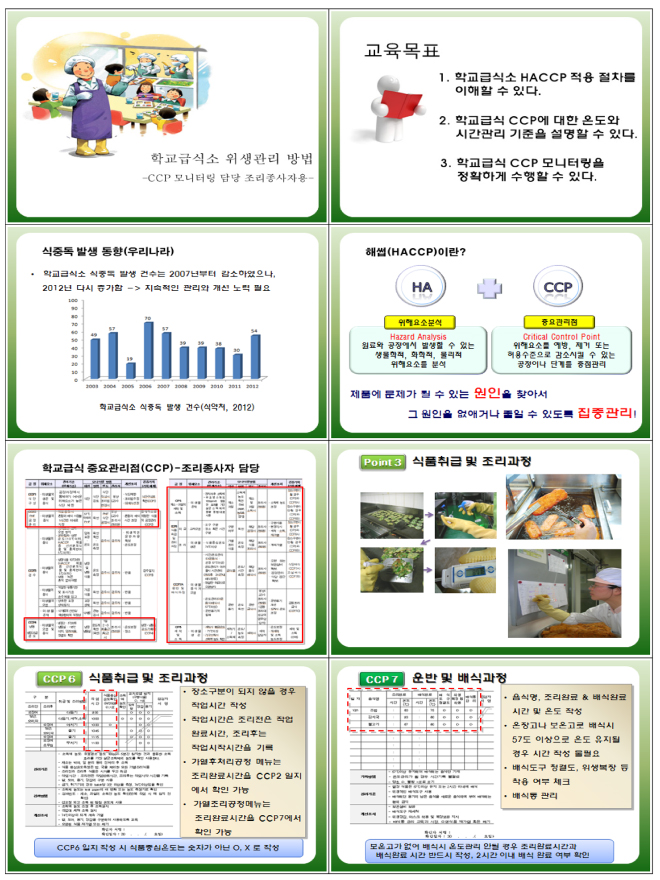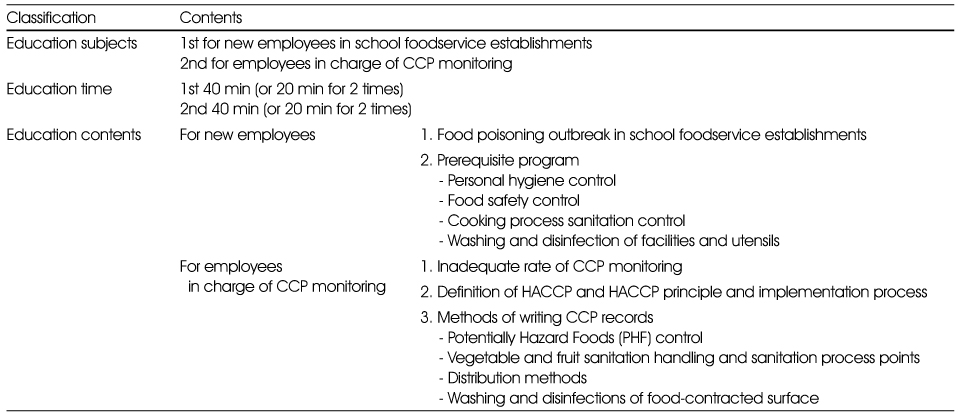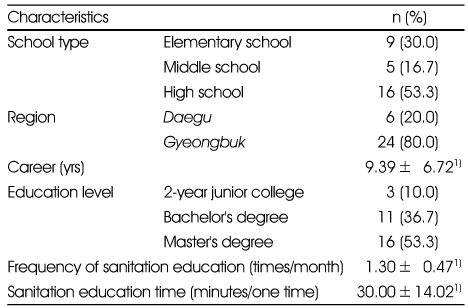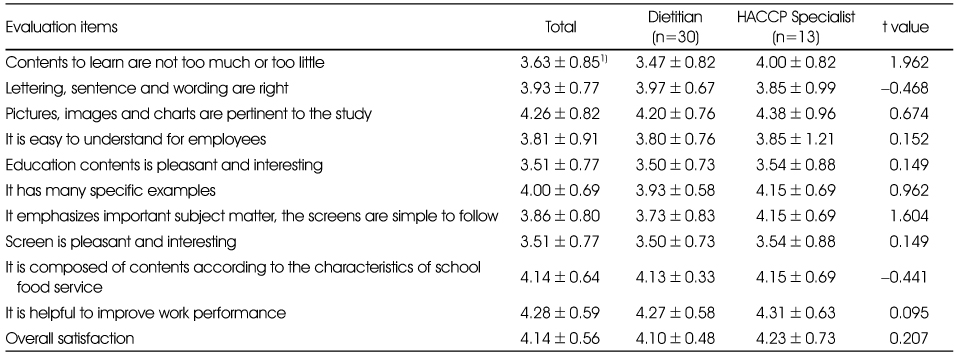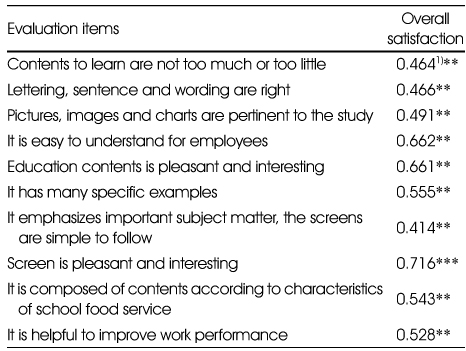References
1. Ministry of Government Legislation. School foodservice operation law [Internet] Ministry of Government Legislation; 2013. cited 2015 Dec 30. Available from:
http://www.moleg.go.kr.
2. Kim GM, Lee SY. Analysis of the school foodservice facilities and sanitary education -Seoul, Gyeonggi, Kangwon and Choongchung areas in Korea-. Korean J Community Nutr 2009;14(5):576–589.
3. Kim EJ, Choi JH, Kwak TK. Analysis of microbiological hazards to determine S. aureus contamination levels at school foodservice operation in Gyeonggi province. Korean J Food Cookery Sci 2009;25(3):365–378.
4. Kim YH, Lee YK. A survey of receiving management of school foodservice in Daegu and Gyeongbuk province. Korean J Food Preserv 2012;19(4):611–618.
6. Kim GM, Lee SY. A study on the sanitation management status and barriers to HACCP system implementation of school foodservice institutions in Seoul metropolitan area. Korean J Community Nutr 2008;13(3):405–417.
7. Hong WS, Yim JM, Choi YS. Sanitary performance and knowledge of elementary school foodservice employees in Seoul. J Korean Diet Assoc 2008;14(4):382–395.
8. Jeon EK, Bae HJ. Evaluation of sanitation management performance within school foodservice facilities and utilities in Gyeongbuk province. Korean J Food Cookery Sci 2009;25(1):62–73.
9. Chang HW, Bae HJ. Assessment of food sanitation knowledge and performance of foodservice workers in school foodservice operations implementing HACCP. Korean J Food Cookery Sci 2010;26(6):781–790.
10. Kim GM, Lee SY. Analysis of TQM-based HACCP system and safety management performance in middle and high school foodservice operations -Seoul, Gyeonggi, Incheon, Kangwon and Chungcheong areas in Korea-. J Korean Diet Assoc 2011;17(1):72–90.
11. Lee HY, Chang HW, Bae HJ. Importance-performance analysis about sanitation management items performed by school food service workers. Korean J Food Cookery Sci 2011;27(1):21–31.
12. Kwon SH, Lee HO, Chung DH, Shin WS, Om AS. The seasonal microbiological quality assessment for application of HACCP system to the elementary school foodservice. Korean J Soc Food Cookery Sci 2003;19(5):647–658.
13. Kim SA, Yi HC, Kim EM, Lee MA, Park JA, Kim JW. Assessment of microbial contamination levels of elementary school classrooms as foodservice environments. Korean J Food Cookery Sci 2007;23(3):321–326.
14. Seo HY, Jung BM. Comparison of foodservice management practices in the employee feeding operations of Jeonnam and Chungchong area. Korean J Community Nutr 2004;9(2):191–203.
15. Park SH, Lim YH. A study on the sanitary management of school foodservice operations in Daejeon and Chungnam. Korean J Community Nutr 2005;10(2):234–242.
16. Lee KE, Lee HS. Influences of school foodservice dietitians' job satisfaction and perception of barriers to HACCP implementation on food sanitation/safety management performance in Gyeongbuk province. J Korean Diet Assoc 2005;11(2):179–189.
17. Soh GS, Kim YS, Shin DH. A survey on the sanitary management in food service institutions. J Food Hyg Saf 2007;22(1):63–75.
18. Lee JH, Goh YK, Park KH, Ryu K. Assessment of food safety management performance for school foodservice in the Seoul area. Korean J Community Nutr 2007;12(3):310–321.
19. Kwak TK, Lee KM, Chang HJ, Kang YJ, Hong WS, Moon HK. Analysis of critical control points through field assessment of sanitation management practices in foodservice establishments. Korean J Food Cookery Sci 2005;21(3):290–300.
20. Kim YS, Jeon YS, Han JS. Inhibition effect of sanitizers against E. coli and a hygienic condition on the surface of utensils and equipments used to food service. J Korean Soc Food Sci Nutr 2002;31(6):965–970.
21. Kim JH, Kim YS, Han JS. Seasonal changes of microbiological counts and sanitation state on the surface of foodservice facilities and utilities. J Korean Soc Food Sci Nutr 2004;33(10):1653–1660.
22. Bae HJ, Lee HY. Importance evaluation about the remedies for improvement of sanitation management by foodservice managers. Korean J Community Nutr 2010;15(2):266–274.
23. Ministry of Education. Food safety manual for school foodservice establishment [Internet] 2010. cited 2015 Dec 30. Available from:
http://www.moe.go.kr/main.do.
24. Lee HY. Verification of the HACCP system and developing remedies for improving foodservice quality at school foodservice establishments [dissertation] Daegu University; 2014.
25. Lee HY, Yang IS, Kang YH, Kim HY. How can we develop and make use of the quality assessment tool of web-based instruction (WBI) for nutrition education? Korean J Nutr 2004;37(4):310–315.
26. Jung HA. The development of web-based education program for foodservice managers [dissertation] Sookmyung Women's University; 2005.
27. Park YH, Kim HH, Shin EK, Jun SY, Lee YK. Development and evaluation of sanitation education media for restaurant employers and employees. J Korean Diet Assoc 2008;14(2):139–151.
28. Ahn HS, Ku BS, Lee SM. Systematic evaluation on the quantitative and qualitative aspects of Korean nutrition education websites. J Korean Diet Assoc 2008;14(3):218–228.
29. Yang HS, Han EH, Sohn HS, Rho JO. A study on the sanitary education program at school foodservice operations in Jeonju. J Korean Living Sci Assoc 2006;9(3):81–87.
30. Um YH. A study on actual sanitary management conditions and education plan of school foodservice employees. Korean J Culinary Res 2010;16(3):237–249.
31. Hong WS, Yim JM. Evaluation of foodservice employees' sanitary performance and sanitary education in middle and high schools in Seoul. J Korean Diet Assoc 2009;15(2):113–127.
32. Yoon JY, Moon HK. Perception of hygiene education and food safety knowledge among new restaurant owners -focused in Gyeongnam area-. J Korean Diet Assoc 2007;13(3):265–276.
34. Garayoa R, Vitas AI, Leturia MD, Jalon IG. Food safety and the contract catering companies: food handlers, facilities and HACCP evaluation. Food Control 2011;22(12):2006–2012.
35. Strohbehn CH, Gilmore SA, Sneed J. Food safety practices and HACCP implementation: perceptions of registered dietitians and dietary managers. J Am Diet Assoc 2004;104(11):1692–1699.
36. Bae HJ, Paik JE, Joo NM, Youn JY. HACCP principles and applications for foodservice manager 1st edth ed. Paju: Kyomunsa; 2012. p. 236–252.


